| Authors: | Alejandro Valdecantos and Ramón Vallejo (CEAM) with input from study sites |
| Editor: | Jane Brandt |
| Source document: | Valdecantos & Vallejo. (2015) Report on structural and functional changes associated to regime shifts in Mediterranean dryland ecosystems. CASCADE Project Deliverable 5.1. |
An area under multiple, diffuse pressures
Twenty-five species were found in the Degraded and Reference plots in Albatera. The multiple stresses acting resulted in a significant reduction of plant cover that reduced from 55.6% in the Reference to 36.7% in the Degraded site (t=-5.776, p=0.004). The three species that showed the highest cover percentage were Artemisia barrelieri, Fagonia cretica and Ephedra fragilis in the Reference (17.9, 13.1 and 6.7%, respectively), and especially Fumana thymifolia in the Degraded sites (24.3%). Only six species were common to the two pressure levels: Brachypodium retusum, Stipa tenacissima (grasses), F. cretica, Globularia alypum, E. fragilis and Anagallis arvensis. This difference in composition and abundance of plant species resulted in a clear separation between plots of the two pressure levels according, mainly, to the first axis of the PCA. PC1 and PC2 account for 39.2 and 23.0% of the variance after including in the analysis all the 25 species found. Echium creticum, Rhamnus lycioides and Anthyllis cytisoides were positively extracted in the significant first axis (eigenvalues of 0.916, 0.867 and 0.820, respectively) while F. thymifolia was heavily negatively extracted on PC1 (-0.959). As mentioned above, this species presented very high cover percentages in the Degraded sites while it was not present at all in the Reference sites. The distance observed in one of the Reference plots along the second axis was due to the low cover of Artemisia barrelieri (7.5%) in relation to the other two plots (20.1 and 26.2%) as this species was negatively extracted on PC2 (-0.644). On the other hand, the three Degraded plots were very close in the PCA representation suggesting more similar plant species composition and cover than the References.
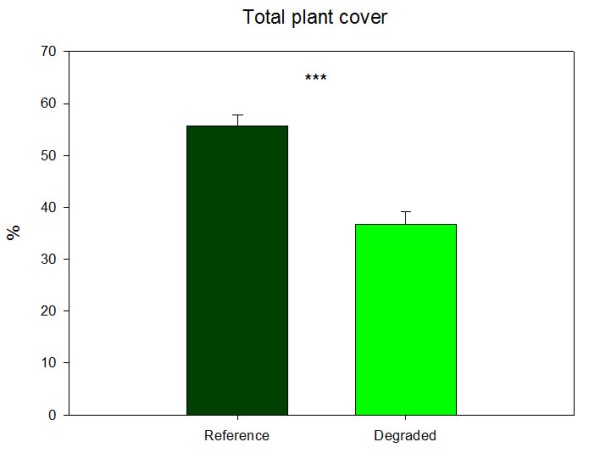
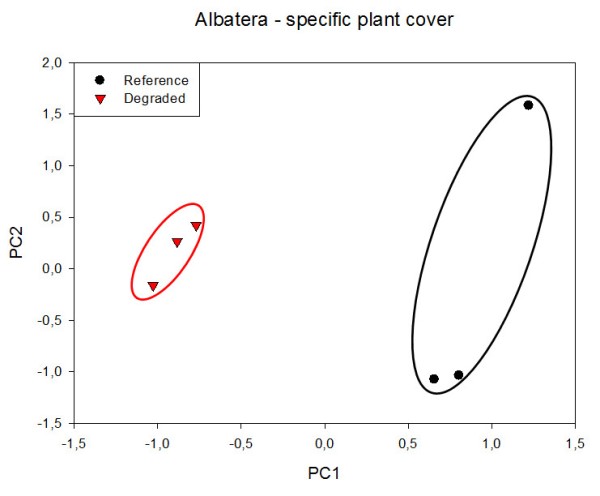
Plant biomass in Albatera was 2.3 times lower in the Degraded than in the Reference plots (t=-14.232, p<0.001) due to the combination of lower total plant cover and the biomass accumulation pattern of the different species occurring in each site.
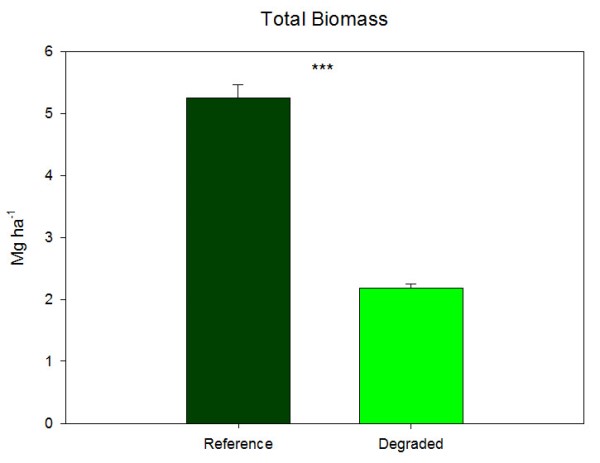
The three diversity indices assessed were significantly reduced as a consequence of the degradation pressure in Albatera. Total number of plant species was reduced in a 40% in the Degraded plots as compared to the Reference (10.3 and 17.3, respectively; t=-2.806, p=0.049). Shannon’s diversity index and evenness also showed significant reductions in the Degraded plots (t=-5.885, p=0.004 and t=-7.846, p=0.001, respectively).

Degradation also significantly modified the spatial distribution of the sink and source areas and the morphology of the vegetation patches. The Degraded sites showed a very high proportion of interpatch areas (91.8%) that were significantly higher than those observed in the References (66.9%; t=9.352, p=0.001). In this site interpatches are mainly bare soil areas heavily exposed to heating and erosion. In addition, the average length of interpatches was significantly higher as well in the Degraded plots (1.69 vs 0.82 m; t=4.812, p=0.037). Similarly, the size of vegetation patches (shrubs, grasses, mixed spots and standing dead plants) were higher in the Reference both in length (50 vs 16 cm; t=-5.957, p=0.004) and width (64 vs 19 cm; t=-6.151, p=0.004). These features have profound consequences in the overall functioning of the resulting ecosystems.
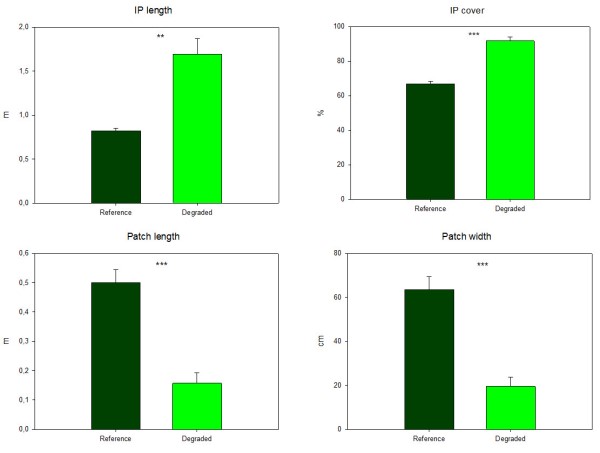
Both systems showed similar degree of stability (54.5 and 52.2% the Reference and the Degraded, respectively) but differed in both the infiltration and the nutrient cycling indices. The loss was highest in the nutrient cycling index as it dropped almost 44% (relative percentage), from 21.5 to 12.0% (t=-8.265, p=0.001), while the infiltration index relatively reduced by 32% (from 27.3 to 18.5%; t=-8.309, p=0.001).
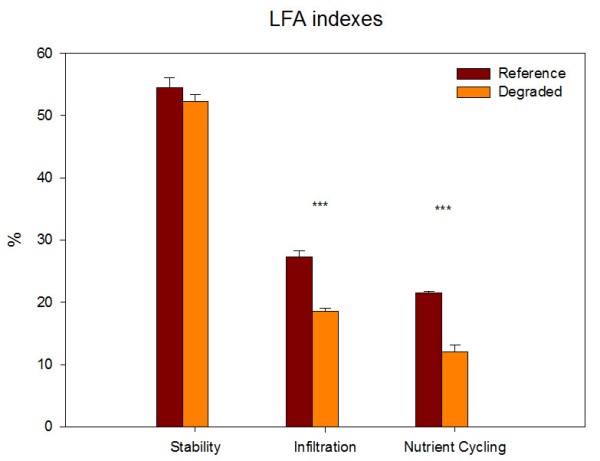
In this field site, the long term degradation due to the combination of climate and land use and mismanagement has led to a significant loss of all ecosystem services assessed. The highest losses were observed in C sequestration (t=-14.055, p<0.001), water conservation (t=-7.838, p=0.014) and nutrient cycling (t=-6.538, p=0.018). This represents a very severe loss of the environmental services provided by the semiarid shrublands in Eastern Spain.
All the ecosystem properties evaluated in Albatera have been reduced by degradation. Increases in interpatch length and cover indicate lower functioning of the ecosystem in soil and water conservation and nutrient cycling. The size of the patches, both in length and width, is the characteristic that showed the highest loss followed by plant biomass and diversity, all of them with losses above 50%.
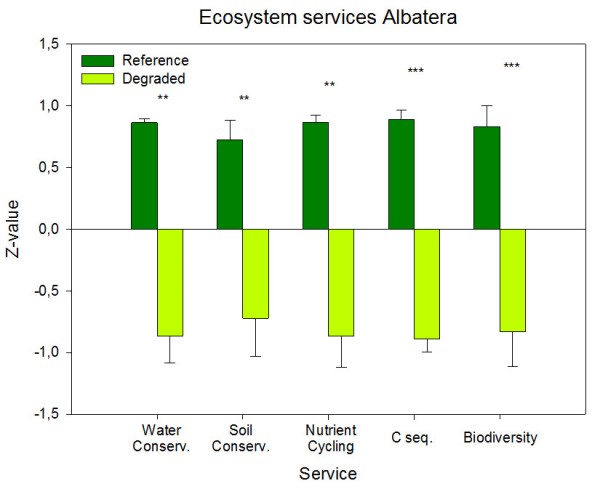
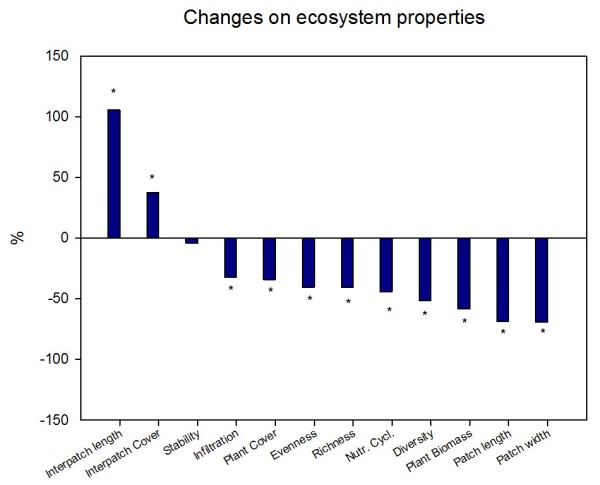
Note: For an overview of the structural and functional changes and their analysis in all study sites see »Structural and functional changes.
